by Robert Verish
![]()
by Robert Verish
Taking Pictures of Meteorites In-Situ
Images of "in-place" meteorites - as they were found on the ground
The subject of this month's "Bob's Findings" article is on the art and science of "in-situ" meteorite imaging, and to explain the importance of taking images or pictures of just found meteorites while they are still "in-place" in the ground.
It's hard to say who was the first to depict their meteorite finds "in-situ", but given the number of finders that are now including "in-situ" images of their meteorites on their web pages, it's safe to say that most readers are familiar with this type of depiction. There are many reasons why one would want to take in-situ images of meteorite finds, just as there are many reasons why one would want to see images of meteorites depicted in their natural setting. An image which shows how a meteorite would appear in its natural setting, on the ground and among the other terrestrial rocks, can be educational to others who are attempting meteorite-recovery.
My personal reasons for taking these images are for reasons that are mostly geological. When I find a meteorite I often find evidence that it has been transported. I use the term "transported" in its geological sense, meaning that it was moved by natural forces. It has been my observation that transported meteorites tend to accumulate. These areas of accumulation are known by the term "stranding surfaces", and it has been my observation that these are very localized, but where they occur more than one type of meteorite has been found. It is my hope that, if I take enough images of these accumulation areas, it will reveal the mechanism that causes this phenomenon.
Granted, the geological information depicted in these images may be more interesting to a geomorphologist, than to a petrologist. But any insight as to how meteorites are accumulating on the surface of our planet will only aid in more of them being recovered, and in turn, help in our understanding of their origins.
The scientific usefulness of these in-situ images may be argueable, but there is no arguing that once a meteorite is plucked from the ground, it can never be put back (unplucked?). Essentially, once the meteorite is extracted, let alone removed from its find site, there is no going back; this information is forever lost.
I thought that I was alone in my peculiar habit of delaying the touching of a newly found meteorite. But back in 1999 I received a message from Paul Gessler in which he confided to me his ritual of delaying the picking up of a find for as much as 20 - 30 minutes. He would take time to contemplate the long journey that this meteorite had taken; to bring it to this spot; and of paths crossed. He was very deliberate about the shots that he took with his film camera. Obviously, it would take some familiarity with meteorites in order to know that a find was indeed a meteorite without having to pick it up.
Here is an image of a Franconia AZ find that was already picked-up and then set back down into the hole that it had just vacated -

It is clearly not the same "in-situ" depiction as this Franconia meteorite that was imaged before it was picked-up -
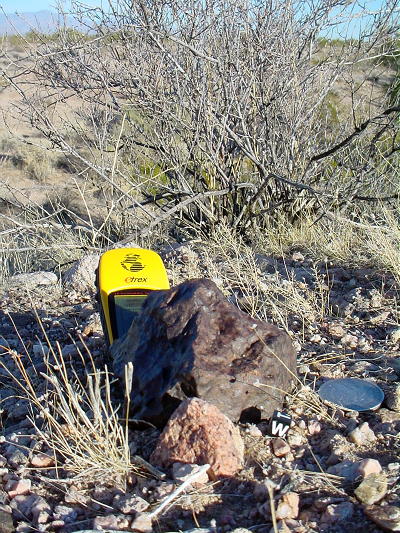
This concept of "in-situ imaging of just found meteorites" may not be appreciated by everybody. It may be percieved by some as being just a trendy way to show your meteorite. And others may not see the distinction between an in-situ image and a picture of a meteorite that was placed down on the ground, irregardless of the fact that it was found somewhere else. But since most of those images are quite obviously NOT an in-situ depiction, I'm sure there is no intent to mislead. And I'm just as sure that if the scientific importance of in-situ images were understood, then these mock in-situ images would certainly not be used and every effort would be taken to avoid any hint of misrepresentation.
The trick to taking informative pictures of "in-situ meteorites" is to take shots from a variety of angles. By taking a variety of camera shots, it increases your odds that, at least, one of your images will be in focus. Personally, I take at least 8 in-situ shots (at various angles and distance) of every meteorite that I find. For example, here are some images that I took in the Franconia (H5) strewn field:
My 1st shot is usually from a point of view that tries to capture the angle from which I first saw the meteorite that I have just found -
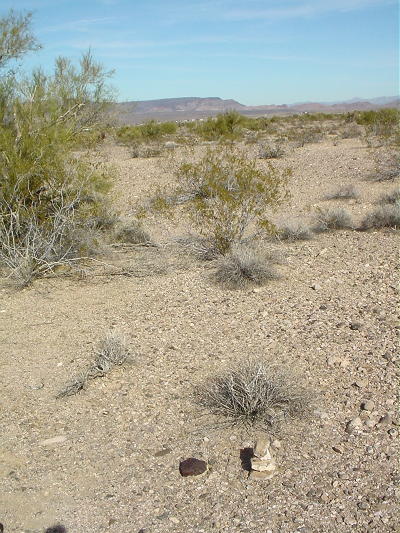
My 2nd shot is a close-up from that same angle -
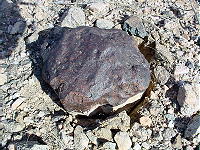
My 3rd shot is another close-up, but this time I place some objects in the scene for scale. Here is where I use my cube-scale or a coin. If possible, I try to include my GPS in this shot, and since I have found that recording the date of the find is often forgotten, I record this as soon as possible with the GPS display. All of my subsequent shots will include this cube-scale or GPS unit for scale -
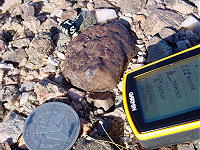
My 4th shot is like the 3rd shot, but this time the GPS is displaying the coordinates. Since this is very important information, the angle of this shot should clearly be able to read the face of the GPS unit -
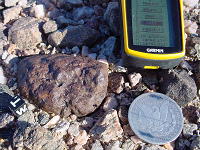
My 5th shot is usually very close up and from a very low angle point of view that tries to capture the side of the meteorite in the foreground and ideally have the background include the horizon -
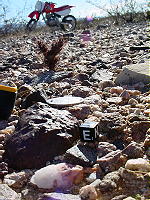
My 6th shot is where I take a few steps back and shot towards the horizon, trying to capture the GPS unit in the foreground and in the middle-ground show as much of the immediate area as is possible -
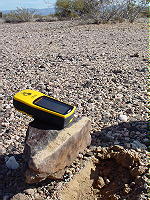
My 7th shot is aimed back down to the ground and is usually an overhead close-up of the meteorite find after it has been just plucked and turned over, now showing its underside and the hole that it has just vacated -
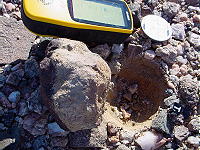
The condition of the soil directly beneath the find is of great interest to those of us recording how meteorites accumulate, so additional shots are usually taken -
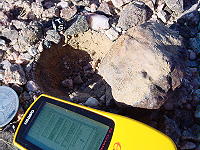
My 8th shot is usually where I hand-hold the find for the first time and try to catch a side of the find that hasn't been imaged, yet. But since the background is of more interest to me, I tend to put that in focus, usually at the expense of the meteorite, which is in the foreground and typically is out of focus -
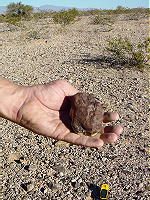
Another shot could be taken, this time to put the hand-held find in focus -
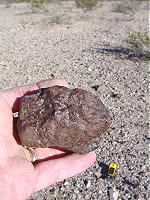
All the meteorites depicted in this article were found in the Franconia area of Arizonza, and all are assumed to be from the H5 fall. John Wolfe was the finder for all of the chondritic stones depicted in this article.
The topic of my next few articles will continue a series on California and Nevada Meteorites.
My previous articles can be found *HERE*
My previous articles from the year 2002 can be found *HERE*
For for more information, please contact me by email:
Bolide*chaser
